|






| |
|
Abercanaid |
|
Merthyr Tydfil |
|
<Click
on photograph to enlarge> |
|
|
 |
Go to:
 |
| |
|
|
| |
Abercanaid
The place meaning Abercannaid is from aber
means ‘mouth of a stream or river’ The word cannaid is a
scarcely-used adjective meaning ‘white’ or ‘bright’ or ‘glittering’;
aber cannaid , the ‘white or bright river-mouth’ . When
large-scale iron-making began in Merthyr Tydfil around 1750, the
centuries of rural farm-life at Abercannaid gradually ended. The
first farm homestead, referred to in the Senghenydd manorial
records for 1449, was probably near the original, now long-lost,
confluence of the stream Nant Cannaid with Afon Taf. In the 1790s,
the Glamorgan Canal Company leased land here. Apart from the canal,
there were several bridges, an overflow channel from the canal to
the river, a dock for canal barges built c.1849, and a quay for
loading coal. Some older residents may recall playing alongside the
dock, with its fine cut stone rims, and on the old cast iron bridge.
Around 1815 the freeholder of Abercannaid was Rowland Thomas and
the lessees were Samuel Morris, the farmer, and Richard Hill of the
Plymouth Iron Company. The first Abercannaid colliery
pre-dates1817and the later one was sunk around the 1830s. Glyndyrys
borders the upper Abercannaid community and the Glyndyrys Pit was
an important coal mine here. The original settlement of Abercannaid
comprised two parallel rows of cottages, with a mine to the west and
a range of farm buildings and farmhouse lay just west of the ‘parish
road’ and the Glamorgan canal. The main course of the river was
possibly straightened for the construction of the Taff Vale Railway
in the 1830s. It is mistakenly said that Sir William Lewis, Lord
Merthyr was born in the large villa called Abercannaid House but
the census of 1841 shows him living in Plymouth Street as a young
child. A Welsh Baptist chapel, Shiloh Chapel, was shown by 1878,
while north of Abercannaid were two engine houses, an adjacent
airshaft, and ironstone level, all of which appear to have been
redundant by 1919. This was an ‘industrial’ village with
coal-mining the main occupation here. The fields on either side of
the re-routed Afon Taf and Taff Vale Railway, and either side of the
road to Abercannaid from the Brandy Bridge, were covered in waste
tipping from the former Plymouth furnaces. By then the furnaces were
in ruins, with the remains of the old rail bridge over the river and
railway. To the south was an enormous waste tip deposited by the
Abercannaid colliery. Until the 1960s local children played all over
this area amongst these ‘industrial remains’ and climbing the tip
was like conquering Everest!
Robert and Lucy Thomas, the early pioneers in
the coal industry to whom the Merthyr Tydfil Fountain is dedicated,
came here and exploited the coal. They lived at Colliers Row in 1805
and at ‘Cwmcannaid’ in 1816. In 1824, Robert Thomas was given
permission by the Plymouth estate to work for coal on Tir y
Waunwyllt. Later he applied to the Glamorgan canal company for
permission to build a wharf adjoining the farm of Glyndyrys. The
bridge oddly called Pont Racks was built around 1850/1855 according
to Bridges of Merthyr Tydfil by Leo Davies, and was used to
take the trams from Waunwyllt colliery across the Glamorgan canal.
As well Abercannaid House and the White Hart Inn, the Thomas family
owned over 40 houses in this small community.
The village expanded in the late 1970s with
modern housing at Anthony’s Grove, near the site of the former Graig
Pit. Three of the old public houses remained, The Colliers Arms, The
Llwyn yr Eos and the Richards Arms. In 1986 a group of 1840s
workers’ houses known as ‘The Squares’ were demolished but other
parts of Upper Abercanaid have been made a conservation area. The
area has changed since the time when the singer Petula Clark was a
child and visited her grandparents in Abercanaid.
C.J. |
|
| |
|
|
|
|
Brandy Bridge September 30th 1933

|
|
Abercanaid,
Quay Row. Abercannaid House, the Large House with the Monkey
Puzzle tree
was said
to be the birthplace
William Thomas Lewis, later Lord Merthyr, one of the last
of the Coal Barons
-(photograph taken in the 1970's.)
|
|
 |
This
photograph from 1910, from a similar
viewpoint,
shows the the Canal and Quay.
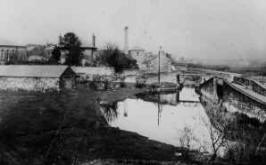 |
|
|
|
|
Abercanaid House |
|
 |
|
|
|
Quay Row in the Snow
(Photograph
Courtesy of the Kenneth J. Gunter Collection) |
|
 |
| |
| Abercanaid, General View |
|
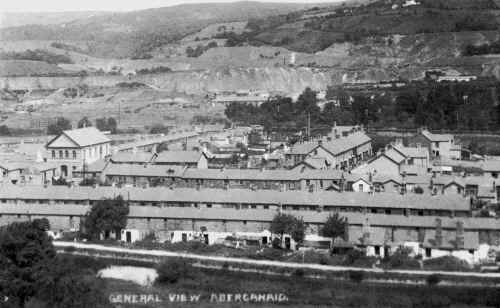 |
| |
| Abercanaid in the 1990's |
|
 |
| |
|
The Board / Abercanaid School
(Photograph
Courtesy of the Kenneth J. Gunter Collection) |
|
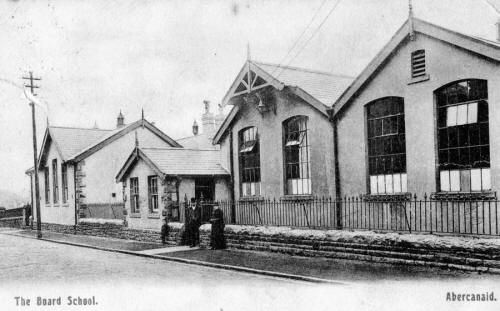 |
| |
|
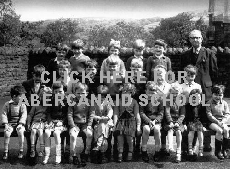 |
| |
| Abercanaid - Post Office |
|
 |
| |
| Cardiff Street , showing
Zion Chapel. |
|
 |
| |
|
Zion Chapel - Abercanaid
(Photograph
Courtesy of Steve Brewer) |
|
 |
| |
|
Street Party at Gethin Street
Nigel Phillips -
Gunter tells us that this photograph
is of the Street Party held on
King George V’s Silver
Jubilee in May of 1935.
The lady at the far end
with a crown on is my
Grandmother Blodwen
Phillips nee Evans. My mother Laura Phillips wasn’t born until October of
1936 but the girl with a blue ink cross on the left is my Aunt Virginia [aka
Virgie]
born 1924 & the boy on the
right with a blue ink cross was my mother & Aunt’s brother & my Uncle Roy
who was born 1930. (Photograph Courtesy of the
Kenneth J. Gunter Collection) |
|
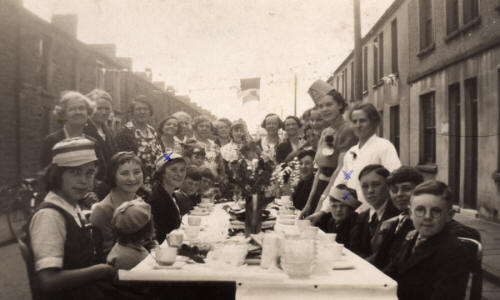 |
| |
|
Street Party at Nightingale
Street, to celebrate the Investiture of Prince Charles, 1969.
(Photograph
courtesy of Anita Rees) |
|
 |
| |
|
Rugby Team outside Greenhill,
Cardiff Street
Shirley Rose (now Vaughan) of Ystrad Mynach
tells us that she believes that here
Grandfather William John
Phillips of Cardiff Street (Born 1882) is on the extreme left 2nd Row.
(Photograph
courtesy of Tim Phillips) |
|
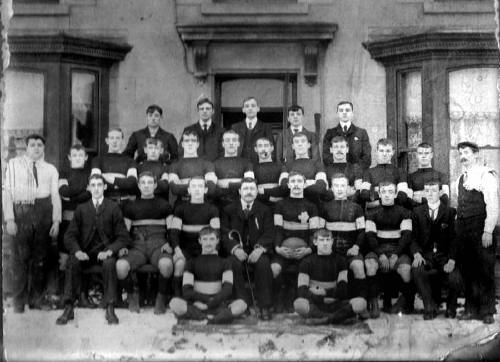 |
| |
|
Rugby Trip to Scotland -
Outside the Richard's Arms
(Photograph
Courtesy of Anita Rees) |
|
 |
| |
|
| |
David Square - Built about 1850 |
|
Davis Square, on the 9th July 1949 |
|
| |
 |
|
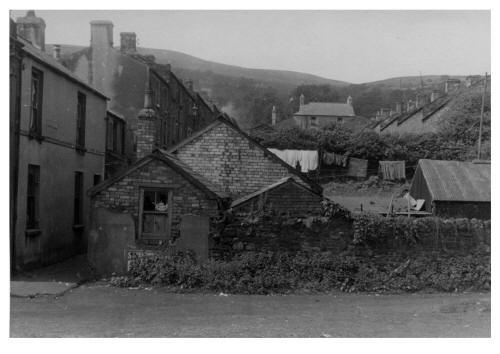 |
|
|
| |
| The Free Library |
|
 |
|
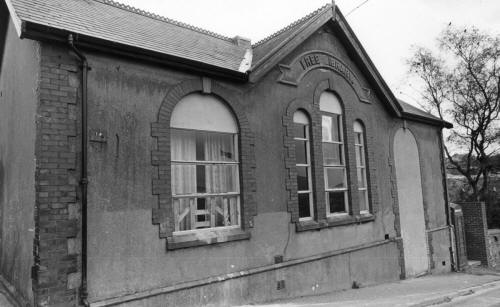 |
| |
|
Deml Chapel
(Photograph
Courtesy of Steve Brewer) |
|
 |
| |
|
Abercanaid Thursdays Cricket
Club. Unbeaten Champions.1935. Merthyr & District League.
Back Row L-R:-
R. Saunders, D.T. Jones, E, Williams, H. Sleeman, R, Davies, E. Jones, Sergt.
Davies, W.J. Williams, W. Ford, A. Morgan, W. Hale, J. Goring Thomas.
Middle Row
L-R:- D.W. Thomas, J. Griffiths, Ll. Richards (Capt), I. Jones, T.E. Davies.
Front Row L-R:-
G. Beavan, W.J. Lewis, H. Thomas, Inset- E. Harris, D.E. Watkins, E. Thomas, B.
Walters.
(Photograph
courtesy of Rod Thomas) Rod
tells us "This
picture is self explanatory except that my father is E. Thomas (Eddie) and
his older brother D. W. Thomas (Walter who kept the drapery shop in
Gethin Street) and younger brother H. Thomas (Harold who lived most of his
life in 1 Chapel Street and his son, Gareth still lives in the village)" |
|
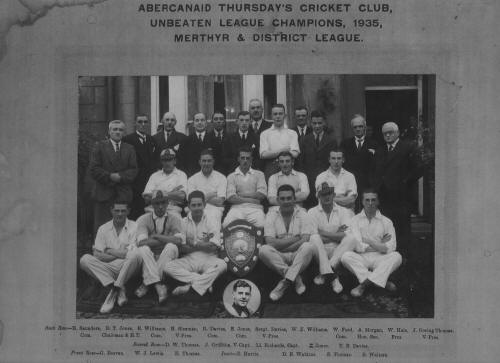 |
| |
|
Do you have
any photographs or information relating to Abercanaid, Merthyr Tydfil?
If so,
please email us, by clicking the 'Contact Us' button. |
| |
|

To the Map |
Go to:
 |
|
|
 |
|















